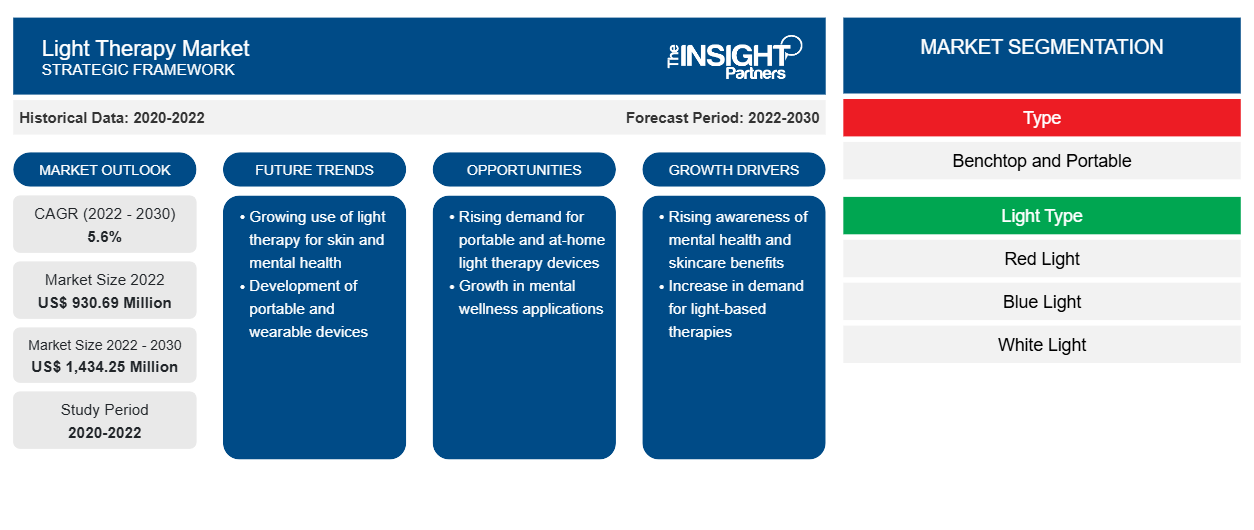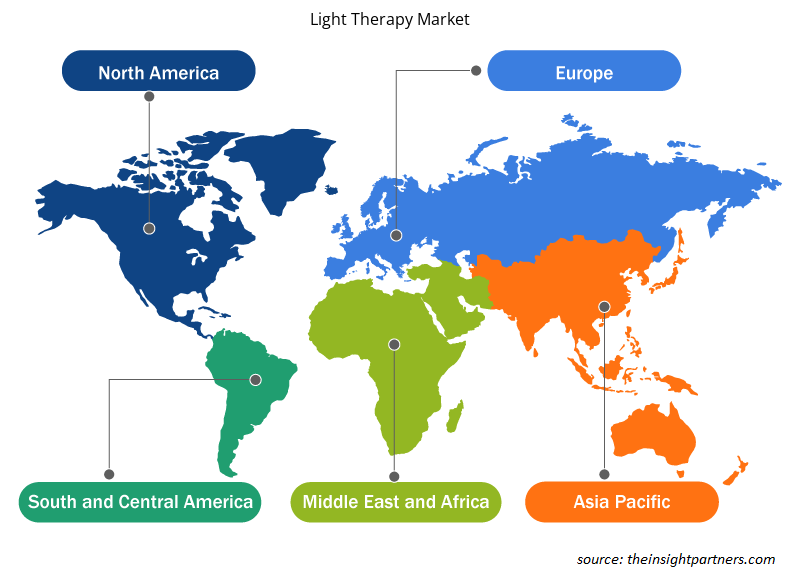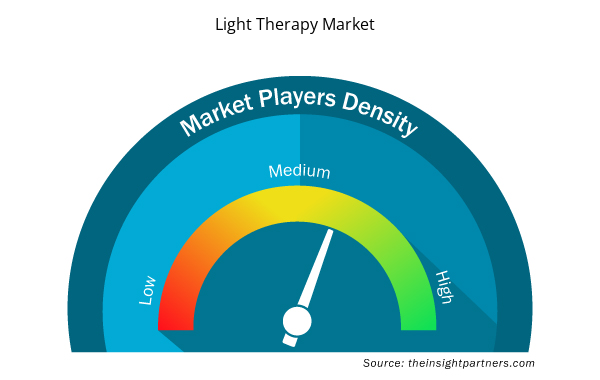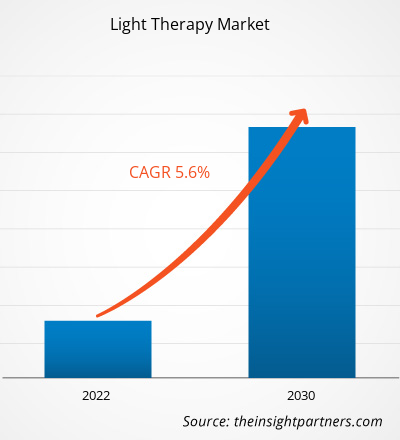[Research Report] The light therapy market size is projected to grow from US$ 930.69 million in 2022 to US$ 1,434.25 million by 2030; the market is anticipated to record a CAGR of 5.6% from 2022 to 2030.
Market Insights and Analyst View:
Light therapy, also known as phototherapy, is the therapeutic use of specific wavelengths of light to address a range of conditions, including dermatological disorders, mood-related disturbances, and sleep-related issues. This noninvasive treatment modality harnesses the unique properties of light to elicit biological responses within the body, often targeting the skin or retina, as well as influencing circadian rhythms and mood-regulating pathways. Light therapy can encompass various forms, such as blue light therapy for acne, red light therapy for skin rejuvenation, and bright light therapy for seasonal affective disorder.
Growth Drivers and Challenges:
The rising adoption of blue light therapy for skin disease has emerged as a significant driver propelling the growth and diversification of the light therapy market. Blue light therapy, a noninvasive phototherapy modality, has witnessed increasing utilization for treating various dermatological conditions, including acne, psoriasis, eczema, and actinic keratosis. The efficacy of blue light therapy in targeting specific skin concerns, such as acne vulgaris, has gained widespread attention and acceptance among healthcare professionals and individuals seeking non-pharmacological treatment options. Technological innovations have further amplified the application of blue light therapy, resulting in the development of specialized light delivery systems with optimized blue light wavelengths that selectively target and mitigate the underlying causes of dermatological conditions. The accessibility of home-based blue light therapy devices has also contributed to the market's expansion, empowering individuals to address skin concerns with convenient and user-friendly solutions.
On the other hand, light therapy offers a range of therapeutic benefits; however, the risk of side effects associated with certain modalities has emerged as a limiting factor for the overall growth of the light therapy market. Concerns regarding potential side effects, such as skin irritation, eye strain, and disruption of circadian rhythms, have raised caution among both healthcare providers and potential users. These concerns can deter individuals from exploring light therapy options, particularly in cases where there is insufficient information or guidance on safe and appropriate usage. Furthermore, the need for meticulous dosimetry and adherence to treatment protocols, coupled with the potential for adverse reactions in sensitive individuals, presents a barrier to widespread adoption. Mitigating these risks through ongoing research, education, and the development of enhanced safety measures will be crucial for addressing these limitations and fostering greater confidence in the safety and effectiveness of light therapy, thereby encouraging its broader utilization and contributing to the market growth.
Customize This Report To Suit Your Requirement
You will get customization on any report - free of charge - including parts of this report, or country-level analysis, Excel Data pack, as well as avail great offers and discounts for start-ups & universities
Light Therapy Market: Strategic Insights

- Get Top Key Market Trends of this report.This FREE sample will include data analysis, ranging from market trends to estimates and forecasts.
Customize This Report To Suit Your Requirement
You will get customization on any report - free of charge - including parts of this report, or country-level analysis, Excel Data pack, as well as avail great offers and discounts for start-ups & universities
Light Therapy Market: Strategic Insights

- Get Top Key Market Trends of this report.This FREE sample will include data analysis, ranging from market trends to estimates and forecasts.
Report Segmentation and Scope:
The light therapy market is segmented on the basis of type, light type, application, and end user. Based on type, the market is divided into benchtop and portable. The light therapy market is segmented by light type into red, blue, and white light. By application, the market is segmented into mental health disorders, skin disorders, neonatal jaundice, and others. In terms of end user, the market is categorized into hospitals and specialty clinics, homecare, and others. In terms of geography, the light therapy market is segmented into North America (US, Canada, and Mexico), Europe (UK, Germany, France, Italy, Spain, and Rest of Europe), Asia Pacific (China, Japan, India, Australia, South Korea, and Rest of Asia Pacific), Middle East & Africa (UAE, Saudi Arabia, South Africa, and Rest of Middle East & Africa), and South & Central America (Brazil, Argentina, and Rest of South & Central America).
Segmental Analysis:
Based on type, the portable segment in the light therapy market is expected to record the fastest CAGR from 2022 to 2030. Portable light therapy devices have revolutionized the accessibility and convenience of light-based treatments, allowing individuals to receive therapeutic benefits on the go. These portable solutions encompass a range of devices, including compact light boxes, wearable light visors, and handheld light wands, designed to deliver targeted phototherapy in various settings. The portability of these devices empowers users to seamlessly integrate light therapy into their daily routines, whether at home, in the workplace, or while traveling. As a result, portable light therapy has expanded the reach of light-based treatments, giving individuals greater control over their wellness regimens and enhancing adherence to prescribed phototherapy protocols.
Based on light type, the light therapy market is segmented into red light, blue light, and white light. Red light treatment is anticipated to gain significant traction in the upcoming years due to its capacity to fortify mitochondria by conducting a biochemical reaction within cells. Thus, red-light therapy has increased adenosine triphosphate (ATP) production, which claims to support hair development, heal wounds, restore tissue, and reverse sun damage.
By application, the light therapy market is segmented into mental health disorders, skin disorders, neonatal care, and others. The hospital skin disorder segment dominated the market in 2022 and is anticipated to register a substantial CAGR during the forecast period. The efficacy of light therapy in treating skin disorders such as acne, psoriasis, eczema, and dermatitis has propelled its widespread adoption among healthcare practitioners and individuals seeking non-pharmacological interventions. This segment has witnessed notable growth due to the advancing research elucidating the photobiomodulatory effects of specific wavelengths of light on skin cells and associated biological processes.
Regional Analysis:
Based on geography, the light therapy market is classified into North America, Europe, Asia Pacific, Middle East & Africa, and South & Central America.
North America is the most significant contributor to the growth of this market owing to the increasing number of people who have psoriasis and SAD/Winter blues symptoms; North America led the world market for light therapy in 2022. Under medical supervision, light treatment entails exposing the skin to UV light from artificial sources. UVB and UVA light, or a mix of the two, are used to alleviate symptoms, lessen inflammation, and limit the proliferation of skin cells. The Canadian Dermatology Association believes that one million Canadians have psoriasis, which is a key factor that drives the demand for light therapy devices. The Asia Pacific light therapy market is expected to record the fastest CAGR from 2022 to 2030, owing to huge investments in telemedicine and increased knowledge of the advantages of light treatment.
Light Therapy Market Regional Insights
Light Therapy Market Regional Insights
The regional trends and factors influencing the Light Therapy Market throughout the forecast period have been thoroughly explained by the analysts at Insight Partners. This section also discusses Light Therapy Market segments and geography across North America, Europe, Asia Pacific, Middle East and Africa, and South and Central America.

- Get the Regional Specific Data for Light Therapy Market
Light Therapy Market Report Scope
| Report Attribute | Details |
|---|---|
| Market size in 2022 | US$ 930.69 Million |
| Market Size by 2030 | US$ 1,434.25 Million |
| Global CAGR (2022 - 2030) | 5.6% |
| Historical Data | 2020-2022 |
| Forecast period | 2022-2030 |
| Segments Covered |
By Type
|
| Regions and Countries Covered | North America
|
| Market leaders and key company profiles |
Light Therapy Market Players Density: Understanding Its Impact on Business Dynamics
The Light Therapy Market market is growing rapidly, driven by increasing end-user demand due to factors such as evolving consumer preferences, technological advancements, and greater awareness of the product's benefits. As demand rises, businesses are expanding their offerings, innovating to meet consumer needs, and capitalizing on emerging trends, which further fuels market growth.
Market players density refers to the distribution of firms or companies operating within a particular market or industry. It indicates how many competitors (market players) are present in a given market space relative to its size or total market value.
Major Companies operating in the Light Therapy Market are:
- Koninklijke Philips N.V.
- Beurer GmbH
- BioPhotas
- Northern Light Technologies
- Lumie
Disclaimer: The companies listed above are not ranked in any particular order.

- Get the Light Therapy Market top key players overview
Industry Developments and Future Opportunities:
A few initiatives taken by key players operating in the global light therapy market are listed below:
- In September 2023, AMIRO, a leading skincare and beauty tech solution supplier, showcased two of the most cutting-edge products of the year—the AMIRO S2 SEAL skin-tightening gadget and the AMIRO LumoMax LED light facial beauty device.
- In June 2022, BioPhotas, Inc. partnered with Ulta Beauty. With the aid of the Celluma PRO and Celluma ELITE models, this cooperation is anticipated to satisfy customers' skincare needs in 55 distinct areas across the US. The FDA has approved these models to treat several ailments, including wrinkles, joint discomfort, and acne.
Competitive Landscape and Key Companies:
Koninklijke Philips N.V.; Beurer GmbH; BioPhotas; Northern Light Technologies; Lumie; Verilux, Inc; Zepter International; The Daylight Company; Zerigo Health; and Naturebright are among the major players in the light therapy market. These companies focus on expanding their offerings to meet the growing consumer demand worldwide. Their global presence allows them to serve many customers, subsequently allowing them to expand their market share.
- Historical Analysis (2 Years), Base Year, Forecast (7 Years) with CAGR
- PEST and SWOT Analysis
- Market Size Value / Volume - Global, Regional, Country
- Industry and Competitive Landscape
- Excel Dataset


- Hydrocephalus Shunts Market
- Animal Genetics Market
- Pressure Vessel Composite Materials Market
- Foot Orthotic Insoles Market
- Digital Language Learning Market
- Military Rubber Tracks Market
- Analog-to-Digital Converter Market
- Greens Powder Market
- Asset Integrity Management Market
- Truck Refrigeration Market

Report Coverage
Revenue forecast, Company Analysis, Industry landscape, Growth factors, and Trends

Segment Covered
Type, Light Type, Application, and End User

Regional Scope
North America, Europe, Asia Pacific, Middle East & Africa, South & Central America

Country Scope
This text is related
to country scope.
Frequently Asked Questions
Based on light type, the light therapy market is segmented into red light, blue light, and white light. Red light treatment is anticipated to gain significant traction in the upcoming years due to its capacity to fortify mitochondria by conducting a biochemical reaction within cells. Thus, red-light therapy has increased adenosine triphosphate (ATP) production, which claims to support hair development, heal wounds, restore tissue, and reverse sun damage.
Based on type, the portable segment in the light therapy market is expected to record the fastest CAGR from 2022 to 2030. Portable light therapy devices have revolutionized the accessibility and convenience of light-based treatments, allowing individuals to receive therapeutic benefits on the go. These portable solutions encompass a range of devices, including compact light boxes, wearable light visors, and handheld light wands, designed to deliver targeted phototherapy in various settings. The portability of these devices empowers users to seamlessly integrate light therapy into their daily routines, whether at home, in the workplace, or while traveling. As a result, portable light therapy has expanded the reach of light-based treatments, giving individuals greater control over their wellness regimens and enhancing adherence to prescribed phototherapy protocols.
The light therapy market is expected to be valued at US$ 1,434.25 million in 2030.
Growing prevalence of skin diseases and the growing use of noninvasive therapies. In 2023, the World Health Organization released estimates that skin diseases impacted over 1.8 million people worldwide. However, the stringent regulatory processes and high cost of devices hinder the growth of the light therapy market.
The light therapy market has major market players, including Koninklijke Philips N.V.; Beurer GmbH; BioPhotas; Northern Light Technologies; Lumie; Verilux, Inc; Zepter International; The Daylight Company; Zerigo Health; and Naturebright.
The light therapy market was valued at US$ 930.69 million in 2022.
Light therapy, also known as phototherapy, is the therapeutic use of specific wavelengths of light to address a range of conditions, including dermatological disorders, mood-related disturbances, and sleep-related issues. This noninvasive treatment modality harnesses the unique properties of light to elicit biological responses within the body, often targeting the skin or retina, as well as influencing circadian rhythms and mood-regulating pathways. Light therapy can encompass various forms, such as blue light therapy for acne, red light therapy for skin rejuvenation, and bright light therapy for seasonal affective disorder.
Trends and growth analysis reports related to Life Sciences : READ MORE..
The List of Companies - Light Therapy Market
- Koninklijke Philips N.V.
- Beurer GmbH
- BioPhotas
- Northern Light Technologies
- Lumie
- Verilux, Inc
- Zepter International
- The Daylight Company
- Zerigo Health
- Naturebright

 Get Free Sample For
Get Free Sample For